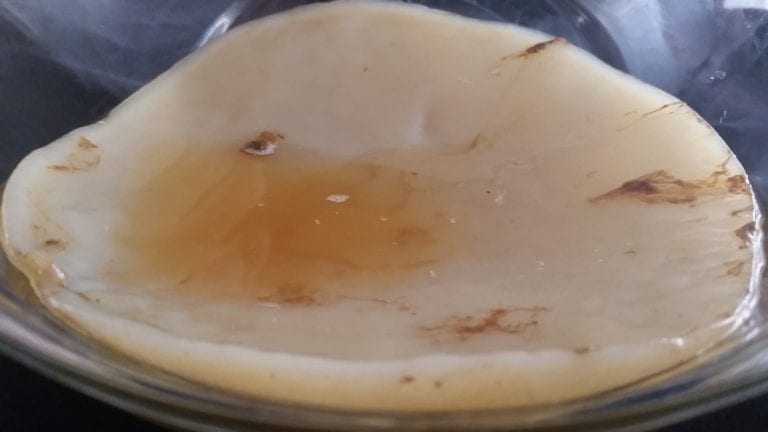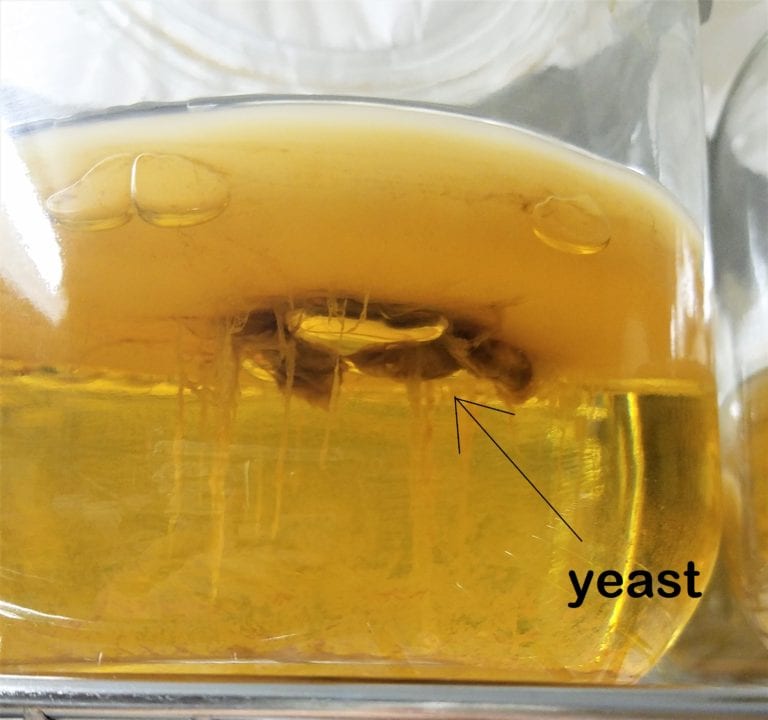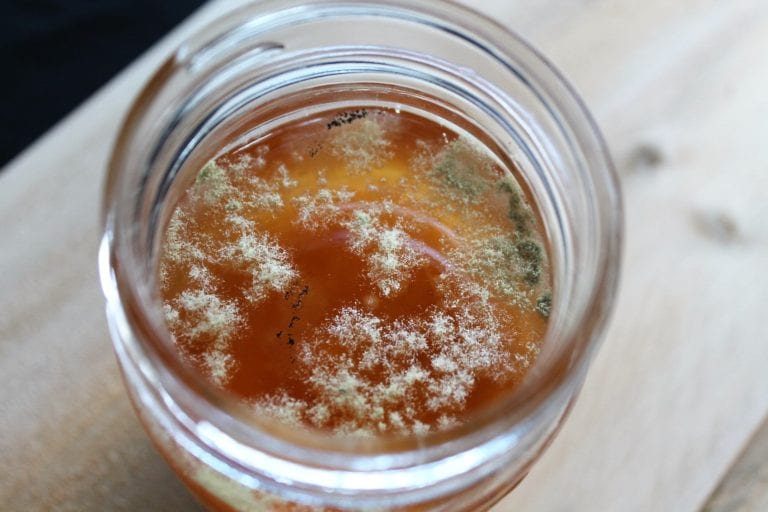SCOBY stands for Symbiotic Colony of Bacteria and Yeast. The bacteria and yeasts work together to ferment sweet tea, resulting in a delicious, probiotic beverage called kombucha. Learn how to make kombucha here.

A SCOBY consists of liquid starter tea and a pellicle. The pellicle, which is nearly always called simply the SCOBY is a cream-colored cellulose mat or pancake-looking disc. The size and shape depend on the brewing container as they grow on the entire surface of the sweet tea.
If you’ve purchased one of our SCOBYs, the pouch will have the best buy date printed on the package and last many months right in the packaging at room temperature. After brewing, reserve a SCOBY and enough starter tea for your next batch. This should be stored at room temperature in a covered jar, the same as the primary fermentation. See our post here for all kombucha brewing ratios.
No. Refrigerating your SCOBY can throw off the microbial populations, which can have negative effects. At proper pH, kombucha cultures can safely be left at room temperature until ready to brew.
What has become the “face” of the SCOBY is layers of cellulose formed by bacteria during fermentation. Within those cellulose layers (and starter tea) are the billions of microscopic organisms that actually make up the SCOBY. See more here in our post on What is a Scoby?
Starter tea is simply matured kombucha. It helps introduce microbes to a fresh batch of sweet tea as well as lower the initial pH to a safe level. See our complete post here on kombucha pH and What is kombucha starter tea?
The starter ratio for brewing kombucha is 9:1 or 90% sweet tea to 10% starter tea. So use 12 fl oz or 1.5 cups of starter tea per 1-gallon batch of kombucha. Various factors can affect the pH, so you should always test to be sure the starting pH is below 4.5. If above 4.5 pH, simply add more starter tea until it reaches this threshold. If additional starter tea isn’t available, in a pinch, you can add 1 tbsp distilled white vinegar. Never use live vinegar, as it has a different microbial population.
For more information, see our post on Kombucha Brewing Ratios
The pH scale is a measurement of acidity ranging from 0-14, where 0 is very acidic and 14 is very alkaline.
Traditional kombucha is brewed with black/green tea and cane sugar while jun tea is brewed with green tea and honey. The starter cultures contain different microbes that thrive on the different substrates.
The sugar in the kombucha is not for you; it is for the yeast! They eat the sugar and create alcohol and CO2, which the bacteria then eat. Depriving them of that sugar would mean a less productive brew. The good news is that, given proper fermenting temperatures, most of that sugar is consumed by the yeast. The longer you let it go, the less sugar will be left. For more information on this topic see our full post here – Can you make kombucha without sugar?
For a traditional kombucha SCOBY, you should stick to plain, organic cane sugar as it is the easiest for it to digest. If you want to use honey, you’ll need to obtain a separate culture, called a Jun Tea culture, that specifically thrives off honey.
Artificial sweeteners are considered non-fermentable sugars and should not be used for primary fermentation. The yeast cannot digest those chemical compounds, so no fermentation will take place. Artificial sweeteners can be used, however, to “back sweeten” during the bottling stage without producing any further fermentation and just add sweetness.
Providing the proper pH for your kombucha gives your SCOBY an upper hand against mold and harmful bacteria. The microbes in the SCOBY prefer an acidic environment, where mold and harmful bacteria cannot survive. Once the fermentation gets underway, the bacteria produce more acids, lowering the pH even more. See our full post here, why is PH important for kombucha?
Nope! The positioning of the SCOBY throughout fermentation is irrelevant. A healthy SCOBY may float, sink, or hover in the middle when air pockets are between the layers. But most will sink. Either way, in time, a new SCOBY will grow on the surface, and the fermentation will go on regardless of position.
For more information, see our post: What Happens if your SCOBY sinks?


This is an extremely common concern question and the vast majority of the time, the “brown stuff” is yeast buildup. This is actually a healthy sign of fermentation but is often mistaken for mold. Below are a few examples of healthy yeast colonies. They create string-like globs that float around. For more information on this, visit the full post here on what’s the brown stuff in my kombucha?
If you’re house is typically below 75°F, there are a couple things you can do to jump start your brew.
First, the kombucha brew can take anywhere from 7-21 days with temperature playing a big role. The warmer the brew, the faster this process is.
Second, purchasing a Fermentaholics SCOBY guarantees quality. Each SCOBY we send out is carefully grown and packed with long-fermented starter tea that is guaranteed to do its part. The SCOBY is only one piece of the puzzle to create a successful brew. Again, more often then not, the brewing temperature zone is off. The SCOBYs need a proper fermenting temperature of 75-85°F or it will ferment extra slow and it will appear nothing is happening.
So what can you do at this point?

Kombucha requires you to use your senses! Smell it. It should begin to give off a vinegary scent, one of the first indicators that it is working. Taste it. As long as the pH is below 4 (test it!) it is safe to begin tasting. The taste should be lightly sour/vinegary and get less sweet with each passing day. Another sign of fermentation is new SCOBY growth. This will occur on the surface of the tea and form to the size of the container it is in. (see photo below–it’s not pretty but that is fresh SCOBY growth occurring on the surface. If left alone, eventually it will grow into a thick pancake-like mass).

Kombucha requires you to use your senses! Smell it. It should begin to give off a vinegary scent, one of the first indicators that it is working. Taste it. As long as the pH is below 4 (test it!) it is safe to begin tasting. The taste should be lightly sour/vinegary and get less sweet with each passing day. Another sign of fermentation is new SCOBY growth. This will occur on the surface of the tea and form to the size of the container it is in. (see photo below–it’s not pretty but that is fresh SCOBY growth occurring on the surface. If left alone, eventually it will grow into a thick pancake-like mass).
Leave it for a few more days. Check the pH to make sure it has lowered to below 4. You may need to place the brew in a warmer spot in your house–temperature is the most commonly overlooked problem for homebrewers. See: Brewing Kombucha In the Wintertime for some tips.
This just means that is has over fermented a little. This can be solved by closely monitoring your next batch, and bottling when it tastes just right. If it is over fermented, it is perfectly safe to consume–try using it in a salad dressing or mask it with a strong flavor during secondary fermentation (try Lemonberry Mint Kombucha!)